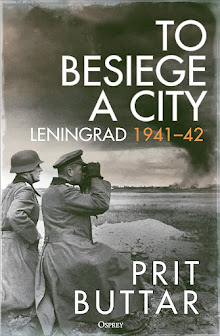This story must start with an acknowledgement of the horrendous suffering borne by the people of this remarkable city from 1941 through to 1944. One of the victims from the siege was called Tanya Savicheva and her iconic image can be seen throughout the city. Her journal is kept at the St Petersburg Museum of History. My friends Natalya Makeeva and Katerina Stepanova translated some passages for me. The journal has been transcribed onto a powerfully evocative memorial which can be found near the start of the 'Road of Life' to the East of the modern day city.
Sunday 22 June 2008
Leningrad (St Petersburg) - A Trip to the Battlefield - May 2006
Leningrad - The City
This page is devoted to a set of pictures taken within the city limits. Many were taken inside one or other of the excellent military museums.
Leningrad - The Oranienbaum Pocket
On 16th September 1941, 1st Panzer Division and 58 & 254 Infantry Divisions slashed through the Russian lines and reached the coast of the Gulf of Finland at Strelna thus cutting off the Russian 8th Army from other forces defending Leningrad.
Leningrad - The North
The Karelian Fortified District (KaFD) existed from 1928 as a line of defence for Leningrad from the north (Leningrad was only 30 - 50 kms from the border). It played a pivotal role during the period 1941-1944 when the Finnish army approached the city from the north. After WW2 the KaFD didn’t lose it's role: from the end of the 1940s and until the middle of 1950s intensive rearmament and building took place.
Leningrad - Siniavino and the South East
Below the Siniavino heights there is a strip of marshy land which extends to the shores of Lake Lagoda. It was through this strip that the 123rd Rifle Division, 67th Army and the 372nd Rifle Division of 2nd Shock Army fought in order to link up thus breaking the siege on January 18th 1943.
Leningrad - The German Fortified Areas in the South
Ropsha is a small town to the South West of St Petersburg. During the siege it was an important hub for the German Army. One of the major siege batteries was stationed in the grounds of the chateau. To the South East was the fortified enclave of Gatchina where Von Leeb (the German commander of Army Group North) had his headquarters. East of Ropsha one can still admire the city of St Petersburg from the Pulkovo heights where the Germans caught their first view of the city in September 1941.
My thanks goes to Natalya Makeeva who introduced Mark and I to the ancient Russian custom of blagging a lift from any passing car. In Russia every car owner in the countryside is a potential taxi driver! Most were astonished that we wanted to go to the middle of knowhere to look at old trench lines, bunkers, etc. We made it back to the airport JUST in time!
Gallipoli (1915) - Anzac & Suvla
God has been kind to the Gallipoli Peninsula. In 1915 it was the stage for suffering on a massive scale but nowadays it is a place of beauty. We visited in May and the place was a picture of perfection. Turqoise water, blue sky, vibrant colours, lush vegetation and an abundance of wildlife. At first glance one has to concentrate hard to remember that this place is sacred ground. The peninsula is now a National Park and is therefore spared the development that has blighted so many battlefield sites.
Gallipoli (1915) - Helles and the Narrows
The place to start with this battlefield is amongst the guns. Many have gone - the monsters mounted on ships like Majestic, Prince George, Ocean, Agamemnon, Inflexible, Vengeance, Irresistible, etc. But ashore there are many - in the forts on the peninsula, on display in towns like Cannakele, on the clifftops on the Asian side of the Straits and amongst the vegetation of the battlefield.
Vietnam - A Trip to the Indochina Battlefields - October 2005
The evidence of Vietnam's post 1945 wars pervades the whole country and yet every Vietnamese person I met seems to have a genuine affection for 'the West' and a real desire to assimilate many aspects of Western culture. The country is a stunning mix of different cultures, dispirate landscapes and eveyone is embued with a deep nationalistic pride. The iconic picture of peasant soldiers (below) can be found in Hanoi's excellent War Museum.














.jpg)




























.jpg)
















